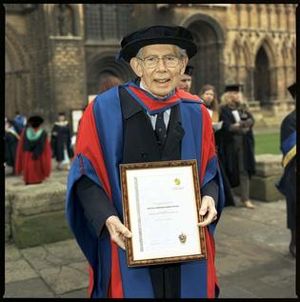Bob Feilden facts for kids
Geoffrey Bertram Robert Feilden (born February 20, 1917 – died May 1, 2004) was a brilliant mechanical engineer. He played a key role in the Power Jets team. This team worked with Frank Whittle to create the world's first jet engine in the early 1940s. Later, he led a committee on engineering design.
Contents
Early Life and Education
Feilden was born in London, England, on February 20, 1917. His father had health issues from the First World War. Because of this, Feilden spent his early years in British Columbia, Canada.
He returned to England when he was eight years old. He attended Heath Mount School and then Bedford School. In 1935, he worked for a year at British Thomson-Houston. This company later became the first home of Power Jets.
In 1936, Feilden went to King's College, Cambridge. There, he studied Mechanical Sciences and Economics. During a summer break in 1937, he worked for the Brown Boveri Company in Switzerland.
Developing Jet Engines
From 1939 to 1940, Feilden worked for Unilever. This was right at the start of World War Two.
Joining Power Jets
In 1940, Feilden joined Power Jets in Rugby. This was the company developing the jet engine. He was in charge of testing the new engines. His work was very important for making the jet engine a success.
Work at Ruston & Hornsby
In 1946, Feilden moved to Ruston & Hornsby in Lincoln. He brought some of his old colleagues from Power Jets with him.
By 1954, he became the Engineering Director. He helped the company start making the TA gas turbine in 1952. The very first commercial turbine was sold to an oil field in Kuwait. He also designed a special diesel engine for ships.
Leading Engineering Design
From 1961 to 1968, Feilden was the leader of the Committee on Engineering Design. In 1963, he wrote an important report. This report was called the Report of the Feilden Committee on Engineering Design. It said that engineering should be more important in Britain. It also argued that engineers should have a higher status.
Working for British Standards
In 1968, Feilden joined the British Standards Institution (BSI). He became the Director General in 1970. He worked for the BSI until 1981.
From 1977 to 1979, he was the President of the European Committee for Standardization. He also served as Vice-President of the Royal Society from 1967 to 1969.
Awards and Recognition
In 1959, Feilden became a Fellow of the Royal Society. This is a very high honor for scientists and engineers. He was also given the title of CBE in 1966. In 1976, he became a Fellow of the Royal Academy of Engineering (FREng).
In 1994, he received the Hodgson Prize from the RAeS. In 2003, The University of Lincoln gave Feilden an honorary doctorate in technology. This recognized his amazing contributions to engineering.
Family Life
Feilden had two wives, both named Elizabeth. He married Elizabeth Gorton in 1946. They had one son and two daughters. He later married Diana Angier.
His son, Richard Feilden, became an architect. He was part of a well-known architecture firm. Feilden's younger brother, Sir Bernard Feilden, was also an architect. He was famous for restoring cathedrals.


